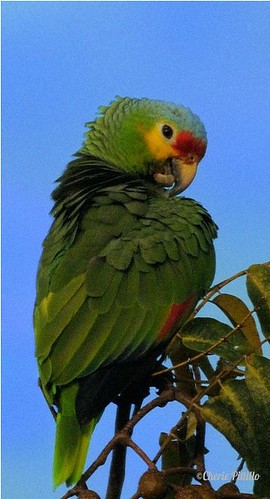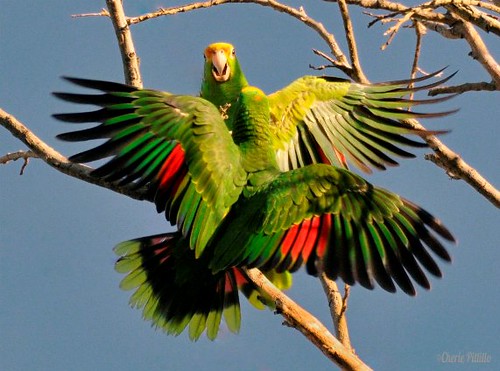 Young Amazona oratrix belizensisMerida finished her annual Carnival celebration this week.
Young Amazona oratrix belizensisMerida finished her annual Carnival celebration this week.
Colorful costumes cascaded along Merida’s streets and even in trees.
Diverse music filled the early morning hours.
These revelers, the Yellow-headed Amazon are newer residents to the upper Yucatan,
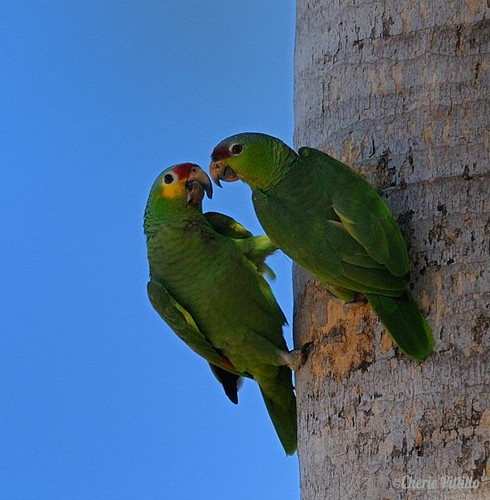 Red-lored and Lilac crowned parrot at palm nesting holeWhile their native cousins, the White-fronted Parrots are official long-term citizens. Look at their white foreheads which can be seen when they fly.
Red-lored and Lilac crowned parrot at palm nesting holeWhile their native cousins, the White-fronted Parrots are official long-term citizens. Look at their white foreheads which can be seen when they fly.
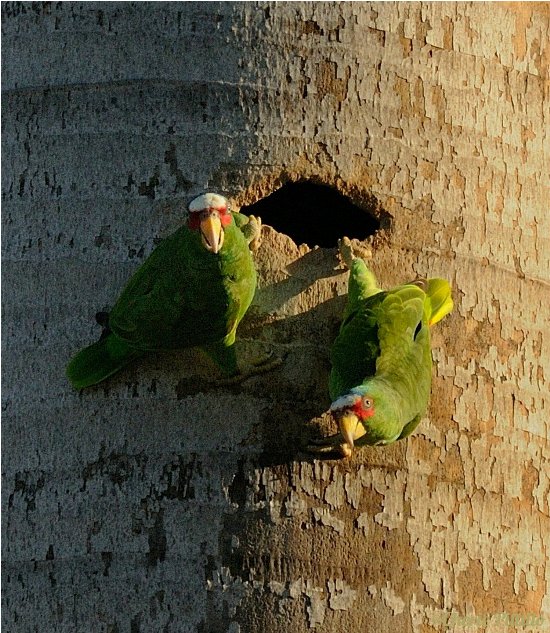 White-fronted Parrot pair at nest hole in palm treeAll 4 species belong to the parrot group called Amazons. “Apparrotly” Christopher Columbus assigned the name “Amazon” to a green parrot that he brought to Europe after his trip from the New World.
White-fronted Parrot pair at nest hole in palm treeAll 4 species belong to the parrot group called Amazons. “Apparrotly” Christopher Columbus assigned the name “Amazon” to a green parrot that he brought to Europe after his trip from the New World.
Almost everyone I know shares a story or two about “their parrots.” In a city of a million people, how many know these gregarious birds that visit their yards are 4 different species?
Last week, I heard two screeching, young Red-lored Parrots in front of my casa while a pair of White-fronted Parrots twirled notes off their tongues out back.
Today I’ll concentrate on the Red-lored Parrots. Part Two will feature White-fronted Parrots.
How nice to find a species appropriately named because the lore(s) in the Red-lored Parrots refer to the space between the front of the eyes and above the base of the bill. Note the red lores of the Red-lored Parrot and the bluish blush on its crown.
In 2002 during Hurricane Isadora, seventeen or so Red-lored Parrots escaped from a large aviary in one of Merida’s neighborhoods according to bird expert and conservationist, Barbara MacKinnon. On Jan. 14, 2013, she observed a flock of 26 flying over Av. Colon and Calle 64, the largest number ever reported. Immature birds were first recorded in 2010 but the permanency of a new species to an area depends on producing young for twenty years.
One morning I heard a flock of ten squawking parrots in our giant tamarind tree. I sneaked up on our roof to watch as one bird transferred a multiple seed pod with its foot to its mouth, peeled off the outer covering of the multiple seed pod, and then squeezed out the fleshy, juicy pulp which dribbled down onto its chest feathers.
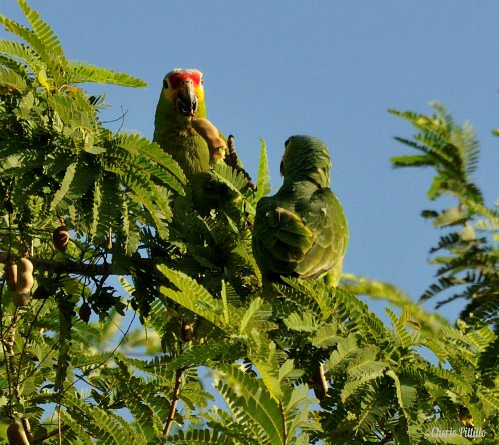 Red-lored Parrots with tamarind seed
Red-lored Parrots with tamarind seed
 Red-lored Parrots with tamarind seed pulp
Red-lored Parrots with tamarind seed pulp
These one foot long, one pound parrots eat other seeds, fruits, nuts, berries, buds, and even blossoms. Their diets are supplemented with leafy matter.
Males and females look alike and reach sexual maturity at three to five years of age.
They are monogamous and participate in mutual preening.
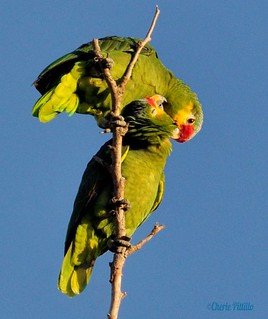 Red-lored Parrot pair preening
Red-lored Parrot pair preening
Nests are usually located in tree cavities especially palm trees. Three to four eggs hatch in about a month. Young leave the nest in about one to two months and lack the red on their foreheads.
Although they range from Mexico to Ecuador and Brazil in forest edges, semi-open areas, and farm land, “our” parrots are commonly seen in the early morning as they announce their flight with loud screeches, screams, and squawks especially along Paseo de Montejo, the Santiago colonias, and even at Immigration headquarters.
 Adult Red-lored Parrot in flight with hybridTheir socializing sounds and glimpses of green add an element of jungle, of wildness in Merida even without Carnival!
Adult Red-lored Parrot in flight with hybridTheir socializing sounds and glimpses of green add an element of jungle, of wildness in Merida even without Carnival!
